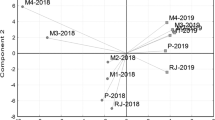Abstract
The influence of collection of volatiles by different headspace sampling techniques was compared for different orange juices, including one fresh unpasteurised, two reconstituted commercial juices and one juice freshly hand extracted in the laboratory. Dynamic headspace sampling from stirred juice samples (DH + S) and notably by purge and trap (PT) sampling gave the highest levels of analysed volatiles, but the composition of the isolated volatiles from the different types of juices varied depending on the volatiles collection method. Aroma sampling by dynamic headspace method without stirring (DH) gave results that reflected the equilibrium aroma composition as determined by static headspace better than that obtained by PT sampling. Totally, 67 aroma constituents were identified among all the orange juices. The largest amount of volatiles was isolated from the fresh commercial, unpasteurised juice, followed by the two reconstituted juices and the hand extracted juice. Limonene was the major constituent of all commercial juices comprising 72–93% of the total peak area of isolated volatiles, meanwhile its amount in the freshly hand extracted juices ranged from 25 to 62% depending on the method of isolation. Qualitatively, the aroma profiles of the freshly extracted oranges and the fresh, commercial unpasteurised juice were described by 62 and 55 aroma compounds, respectively, which included large proportions of esters and aldehydes. Only 41 and 34 aroma compounds, mainly terpenes, were identified in the reconstituted orange juices.

Similar content being viewed by others
References
US Department of Agriculture Foreign Agricultural Service (2004) Available via http://www.fas.usda.gov/htp/Hort_Circular/2004/08-04/8-31-04%20Orange%20Juice% 20Feature.pdf
UNCTAD Market Information (2004) Available via http://r0.unctad.org/infocomm/anglais/orange/technology.htm
Nisperos-Carriedo M, Shaw PE (1990) J Agric Food Chem 38:1048–1052
Moshonas MG, Shaw PE (1997) J Essent Oil Res 9:3–139
Shaw PE, Buslig BS, Moshonas M (1993) J Agric Food Chem 41:809–813
Shaw PE, Moshonas M, Buslig BS, Barros SM, Widmer WW (1999) J Sci Food Agric 79:1949–1953
Shaw PE, Rouseff RL, Goodner KL, Bazemore R, Nordby HE, Widmer WW (2000) Lebensm Wiss u Technol 33:331–334
Buettner A, Schieberle P (2001) ACS Symp Ser 782:33–45
Buettner A, Schieberle P (2001) J Agric Food Chem 49:2387–2394
Rouseff R, Bazemore R, Goodner K, Naim M (2001) In: Rouseff R, Cadwallader KR (eds) Headspace analysis of food and flavors: theory and practice. Kluwer Academic/Plenum, New York, pp 101–112
Guth H, Grosch W (1993) Flavour Fragr J 8:173–178
Hinterholzer A, Schieberle P (1998) Flavour Fragr J 13:49–55
Adams RP (1995) Identification of essential oil components by GC/MS. Allured, Carom Stream, IL
Moshonas MG, Shaw PE (1994) J Agric Food Chem 42:1525–1528
Moshonas MG, Shaw PE (1997) J Food Qual 20:31–40
Maccarone E, Campisi S, Fallico B, Rapisarda P, Sgarlata R (1998) J Agric Food Chem 46:2293–2298
Pino J, Toricella R, Orsi F (1986) Nahrung 30:783–790
Hunter GLK, Brogden WB (1965) J Food Sci 30:383–387
Acknowledgements
The authors wish to thank Marius Gudauskas, Socrates Exchange student from the Department of Food Technology, Kaunas University of Technology, Lithuania for the assistance in GC-FID analysis
Author information
Authors and Affiliations
Corresponding author
Rights and permissions
About this article
Cite this article
Bylaite, E., Meyer, A.S. Characterisation of volatile aroma compounds of orange juices by three dynamic and static headspace gas chromatography techniques. Eur Food Res Technol 222, 176–184 (2006). https://doi.org/10.1007/s00217-005-0141-8
Received:
Accepted:
Published:
Issue Date:
DOI: https://doi.org/10.1007/s00217-005-0141-8




